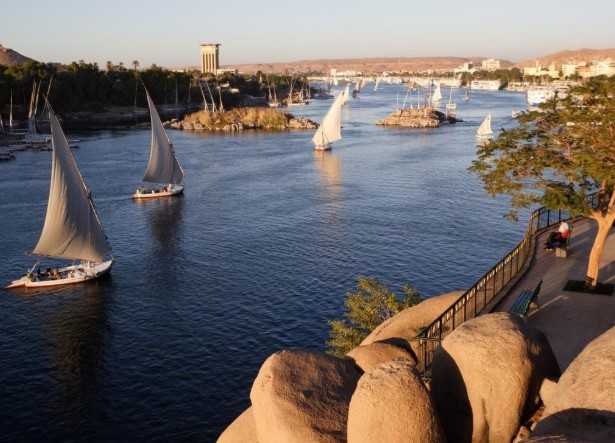A journey down the Nile is a journey through the soul of Egypt. While most travelers opt for modern cruise ships or high-speed trains, the traditional felucca trip from Aswan to Luxor.offers a slow, soulful, and authentic experience that reconnects you with the spirit of the ancient land. This voyage isn’t just a mode of transportation; it’s a cultural immersion, a return to the rhythms of nature, and a passage through the heart of ancient civilization.
What is a Felucca?
A felucca is a traditional wooden sailboat used along the Nile since pharaonic times. Powered by the wind and steered manually, it has a triangular canvas sail and no motor, giving it a quiet, peaceful movement. Feluccas are typically modest in size and are ideal for small groups seeking an intimate and personalized travel experience.
Unlike the bustling cruise ships, feluccas offer no luxury cabins or onboard buffets. Instead, they deliver an enriching and minimalist experience that aligns you with the river’s natural cadence. You sleep under the stars on deck, dine on freshly cooked local meals, and stop in tranquil villages that most tourists never see.
Starting Point: Aswan – Gateway to Nubia
Your journey begins in Aswan, a serene and sun-drenched city in southern Egypt known for its Nubian culture, granite quarries, and stunning temples. Aswan’s laid-back charm is the perfect introduction to felucca life. Before departure, it’s worth visiting local landmarks like the Philae Temple, High Dam, and Unfinished Obelisk.
Boarding the felucca usually occurs near Elephantine Island or the Corniche. A typical crew consists of a local captain and a cook, both often Nubians who bring rich cultural storytelling to the trip. The felucca’s deck is covered with cushions and mattresses, where travelers relax, socialize, eat, and sleep.
The Journey: Aswan to Luxor – A Voyage Through Time
The direct sailing distance between Aswan and Luxor is around 215 kilometers, but due to the slow pace of the wind-powered felucca and multiple stops along the way, the journey can take 3 to 5 days, depending on wind conditions and your chosen itinerary.
Most feluccas don’t travel the entire way to Luxor by river, as large stretches between Kom Ombo and Edfu are not navigable by sail alone due to dams or wind patterns. Therefore, most tours include a combination of felucca travel from Aswan to Kom Ombo or Edfu, and then a transfer to Luxor by minivan or taxi for the final leg.
Here are the major highlights along the route:
1. Kom Ombo – Temple of Dual Deities
The felucca trip from Aswan to Luxor. usually docks near Kom Ombo, where you disembark to explore the Temple of Kom Ombo, uniquely dedicated to two gods: Sobek, the crocodile god, and Horus, the falcon-headed god. This riverside temple is particularly beautiful at sunset and features mummified crocodiles in a small but fascinating museum.
2. Edfu – Best-Preserved Temple in Egypt
From Kom Ombo, most travelers take a road transfer to Edfu, home to the grand Temple of Horus. This is the best-preserved temple in Egypt, with towering pylons, intact reliefs, and sacred chambers that reveal ancient ritual practices. Walking through its massive columns, one can almost hear the echoes of chants from 2,000 years ago.
3. Riverbank Life – Villages and Natural Beauty
One of the greatest joys of a felucca trip is witnessing everyday life along the Nile. You’ll pass lush palm groves, banana plantations, and mud-brick villages where water buffalo and donkeys roam freely. Stops for swimming, village walks, or tea with locals provide opportunities to connect with rural Egyptian life, far from the touristic hustle.
Nights are often spent docked at secluded riverbanks or small islands, where campfires are lit, traditional songs are sung, and the stars glitter unfiltered by urban light.
4. Local Cuisine on Board
Your onboard meals are typically cooked fresh by the crew and include traditional Egyptian fare like koshari, grilled vegetables, falafel, rice, stews, and flatbreads. Hot mint tea is served frequently, especially during sunsets when the felucca glides silently through golden reflections.
Despite the simplicity, the food is flavorful, nutritious, and deeply satisfying after a day in the sun.
5. Arrival in Luxor – Ancient Thebes
Once the felucca trip concludes—usually in Edfu or Esna, depending on wind and current—you’ll be transferred by vehicle to Luxor, the ancient capital of Thebes and one of the most archaeologically rich cities in the world.
Here, you can explore the Karnak Temple Complex, the majestic Luxor Temple, the Valley of the Kings, Hatshepsut’s Mortuary Temple, and many more wonders that chronicle over 3,000 years of pharaonic glory.
Why Choose a Felucca Trip Over a Nile Cruise?
While luxury cruises offer comfort and convenience, felucca trips are chosen by travelers who prioritize authenticity, simplicity, and connection to nature. Here are key benefits:
- Intimate Experience: Small group size means personal attention and genuine interaction with your hosts.
- Eco-Friendly: No motor = no pollution; sailing is sustainable and peaceful.
- Budget-Friendly: Felucca trips are significantly cheaper than cruise packages.
- Cultural Depth: Stops in untouristed villages offer rare glimpses into daily life.
- Adventure Spirit: Sleeping on deck and living with the elements builds lasting memories.
What to Expect and Prepare
- Facilities: Feluccas have basic toilet arrangements (often on land or shared at stops), and no showers.
- Weather: Days are hot, especially from May to September, but nights can be chilly. Bring layers.
- Gear: Bring sunscreen, insect repellent, flashlight, wet wipes, power bank, and a sleeping bag liner.
- Flexibility: Since felucca trips depend on wind, schedules can be unpredictable. Patience and openness to change are key.
Conclusion: Sailing into History
A felucca trip from Aswan to Luxor.is not just a journey down a river—it’s a journey into the heart of Egypt’s heritage, through landscapes that have witnessed the rise and fall of empires. It is a voyage for the soulful traveler—one who finds beauty in simplicity, meaning in slowness, and awe in history.
As the sun sets behind the palm trees and the sail catches the Nile breeze, you’ll understand why for thousands of years, people have been drawn to this river—not just to cross it, but to experience it. The felucca offers that experience in its purest form.

